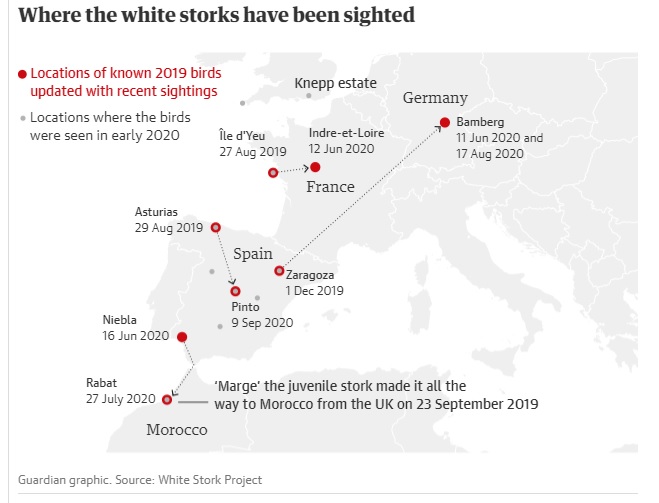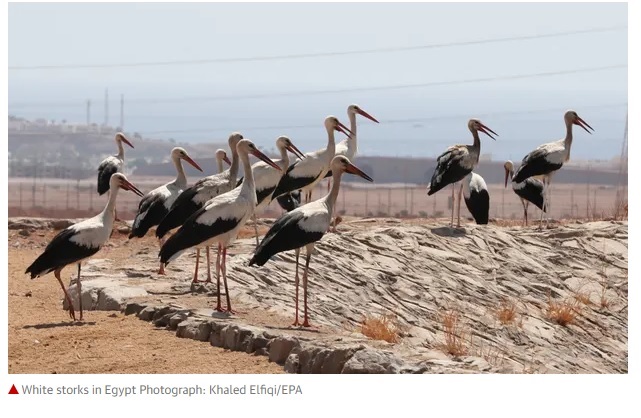The Guardian
Patrick Barkham @patrick_barkham
Scientists look forward to data from tags tracking captive-bred white storks at a West Sussex farm.
Marge, a white stork released onto a rewilded farm in West Sussex, is shedding light on the birds’ unpredictable migratory habits by flying to Morocco for her first winter and spending the summer in Spain.
Scientists are using satellite tags to track white storks released onto the Knepp estate to learn what migratory habits the captive-bred birds will develop.

When the project began, sceptics claimed that captive-bred storks would not migrate but the birds released at Knepp quickly crossed the channel at Dover.
Data from the White Stork Project, which aims to establish them as a breeding bird in the UK, reveals that many of the birds spent their first winter overseas at landfill sites in southern Europe and northern Africa, where they joined other birds in large numbers to feed.
Tags were fitted by scientists from the University of East Anglia and Durrell Wildlife Conservation Trust to eight storks in 2019 for a trial, with eight more fitted to young storks this year.
“There is a high level of excitement and anticipation after deploying the tracking devices, as we don’t know what the birds will do or if they will survive the migration,” said Dr Aldina Franco, associate professor in ecology at UEA.
Storks living in central and northern Europe migrate to southern Europe and Africa in the autumn, with an eastern route and a western route. The captive-bred birds are offspring of storks originally brought from Poland and so some researchers expected them to use an easterly migratory path.
Franco said: “In the past, British storks probably used the western migratory route but storks from Poland use the eastern migratory way. In southern Europe some populations are no longer migratory and spend the whole year near the breeding area.
“In 2019 some of my colleagues were positive the UK storks would remain in the country, others thought they would migrate using the western migratory route, while I thought they follow their parents’ route towards the east. In fact, we were all right, and astonished to see the diversity of strategies individuals adopted.
“The 2020 storks will encounter other individuals and follow leader birds – older animals that are more experienced – in migration. They may spend winter in a range of locations depending on the storks they encounter on the way.”
Lucy Groves, white stork project officer for Durrell Wildlife Conservation Trust, said storks helped people first grasp the epic scale of bird migration when one appeared in Germany in 1822 with an African spear through its neck.
She added: “It has been fascinating to follow the individual migration routes taken since August 2019 and the data collected is allowing us to build up a picture of the wide range of behaviours and patterns displayed by our juveniles.
“The combination of sightings and GPS data has shown that these juveniles are integrating with wild populations of storks, following the more experienced birds once they meet them in Europe. I am looking forward to seeing if our 2020 juveniles pick the same or different routes and if any will join Marge in Morocco.”
Of the young birds released and tagged this year, three storks are currently feeding on landfill sites in Spain, two in France and one in Britain. One stork died in Britain and another stopped transmitting in France.
Last month, 19 captive-bred storks were released at Knepp, joining another four juvenile storks that fledged from two nests in the wild at Knepp this year – the first successful nests in Britain since the 15th century.
The last breeding record was a pair who nested on the roof of St Giles Cathedral in Edinburgh in 1416, although some ornithologists argue there is a lack of evidence the species was ever widespread in Britain.
News is under threat …
… just when we need it the most. Millions of readers around the world are flocking to the Guardian in search of honest, authoritative, fact-based reporting that can help them understand the biggest challenge we have faced in our lifetime. But at this crucial moment, news organisations are facing a cruel financial double blow: with fewer people able to leave their homes, and fewer news vendors in operation, we’re seeing a reduction in newspaper sales across the UK. Advertising revenue continues to fall steeply meanwhile as businesses feel the pinch. We need you to help fill the gap.
We believe every one of us deserves equal access to vital public service journalism. So, unlike many others, we made a different choice: to keep Guardian journalism open for all, regardless of where they live or what they can afford to pay. This would not be possible without financial contributions from those who can afford to pay, who now support our work from 180 countries around the world.
Reader financial support has meant we can keep investigating, disentangling and interrogating. It has protected our independence, which has never been so critical. We are so grateful.
We need your support so we can keep delivering quality journalism that’s open and independent. And that is here for the long term. Every reader contribution, however big or small, is so valuable. Support Th







